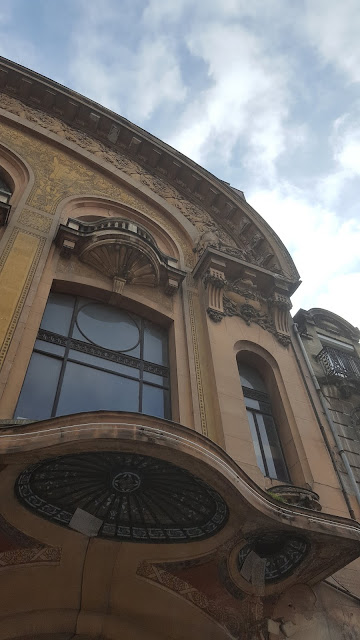From the devastation wrought by the hostilities of the First World war, the city of Reims finally rose up again from the ruins. Commonly referred to as the martyred city of France, beseiged Reims was the target of over three years of heavy bombardment from the Germany army occupying surrounding land. Le crime de Reims gradually brought the city to its knees, right from the onset of war in September 1914 and there was no greater symbol of this destruction than the burnt and battered cathedral. Over 80% of the Cité des Sacres had been reduced to rubble by 1918.
The 1920s witnessed the unfolding of a vast reconstruction programme throughout Reims. In the interwar period, more than 300 architectural firms set about creating the new face of Reims, city of coronations and champagne. With an eclecticism that resulted in the oddest ensemble of buildings, there was a particular emphasis on the Art Déco style. Reims can only be truly appreciated by lifting the line of vision so as to take in the strange collection of features that reward the curious eye.
Whilst the name of this hybrid phoenix is somewhat unattractive - L’Operaims – the concept seems promising so it would seem that all is well that ends well. But what of the soon-to-be deserted site of L’Opéra ? The years I have spent here have seen a sad decline in the state of the façade, despite it being included on the Inventaire Supplémentaire des Monuments Historiques in 1981. The basement of the building housed a pizza restaurant for a long time, but nothing was done to maintain the façade in a decent condition. One may well wonder how metal grids, hideous lighting etc can be bolted onto architecture of such character. Nothing has been done to repair broken glass in the marquise or the stained-glass windows, or the other features – all of which leaves the pigeons and their droppings to cause further damage. How can a city council allow this to happen, whilst letting the ugly shop fronts of KFC and the like to spring up on the historic heart of Reims?
Apparently, a new complex is under way, led by Bouygues Immobilier, in order to "build the future with respect for the past". The façade will be restored, thank goodness, as will be the old foyer (not to be confused with the ugly present-day entrance of the cinema). The site will be divided up to create office space and accommodation – going from basic studios to large flats, all benefiting from this prime location in the city centre, with certain appartments looking onto the cathedral. Apparently the properties will be ‘intelligent’ , ie equipped with all types of state-of-the-art gadgetry operational from a smartphone. Hmmm… Cue scenes from Jacques Tati’s 'Mon Oncle'! New underground parking facilities will also be created nearby. In short, much of the original site is to be gutted to accommodate the changes required, a tried-and-tested practice that is frequent today when dealing with old buildings due for redevelopment.
All that is often left of the original structure is the shell, with a few key decorative features, but I suppose we should be grateful for that, at least. Nevertheless, it makes me all the more appreciative of individuals who take on vast restoration projects in order to return architectural beauty to its original state. La Villa Démoiselle is a perfect example of such an incredible feat.
All in all, the final renaissance of the old site of L’Opéra-Cinéma must surely be a very lucrative deal above all else, but if it means the façade is treasured in the way it merits, so be it… Reims centre also gets to keep its cinema, adding life to Place d’Erlon and providing me with the English films I might not manage to see on the big screen otherwise!










No comments:
Post a Comment
Leave a message - please share your ideas!